
Study designs for cervical dystonia
The efficacy of Dysport was evaluated in 2 randomized, double-blind, placebo-controlled, single-dose, parallel-group studies in 252 patients with cervical dystonia (CD; [Dysport, n=121; placebo, n=131]). Patients who had CD symptoms for at least 18 months received either Dysport or placebo. Inclusion criteria included Toronto Western Spasmodic Torticollis Rating Scale (TWSTRS) total score ≥30, severity sub-scale score ≥15, disability sub-scale score ≥3, and pain sub-scale score ≥1.1,2
Dysport 500 Units was given by intramuscular injection, divided among 2 to 4 affected muscles. The primary efficacy endpoint in both studies was total TWSTRS change from baseline at Week 4.1
- Study 1: the mean TWSTRS total score at baseline was 45.8 for placebo and 43.8 for Dysport 500 Units
- Study 2: the mean TWSTRS total score at baseline was 46.2 for placebo and 45.1 for Dysport 500 Units
These studies were followed by long-term, open label extensions that allowed titration in 250-Unit steps to doses in a range of 250 to 1000 Units, after the initial dose of 500 Units.1
Study design for cervical dystonia1-4
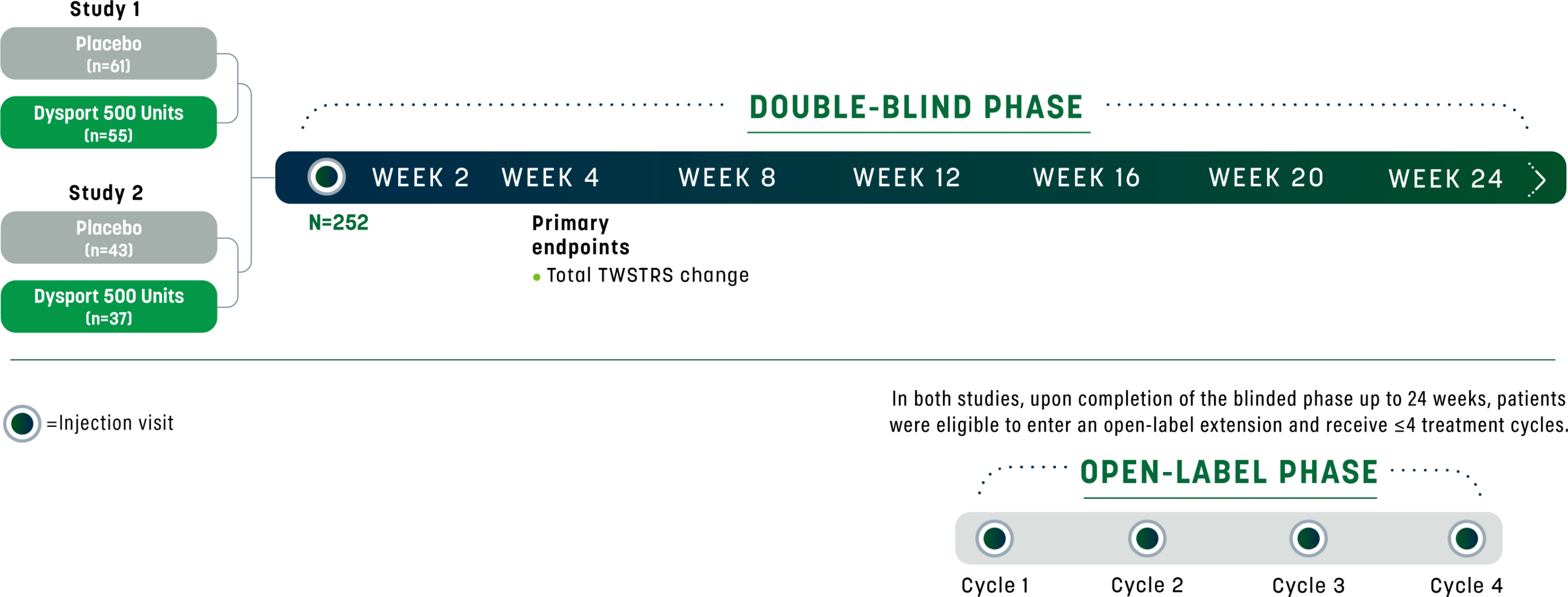

Head posture in CD
STUDY 1
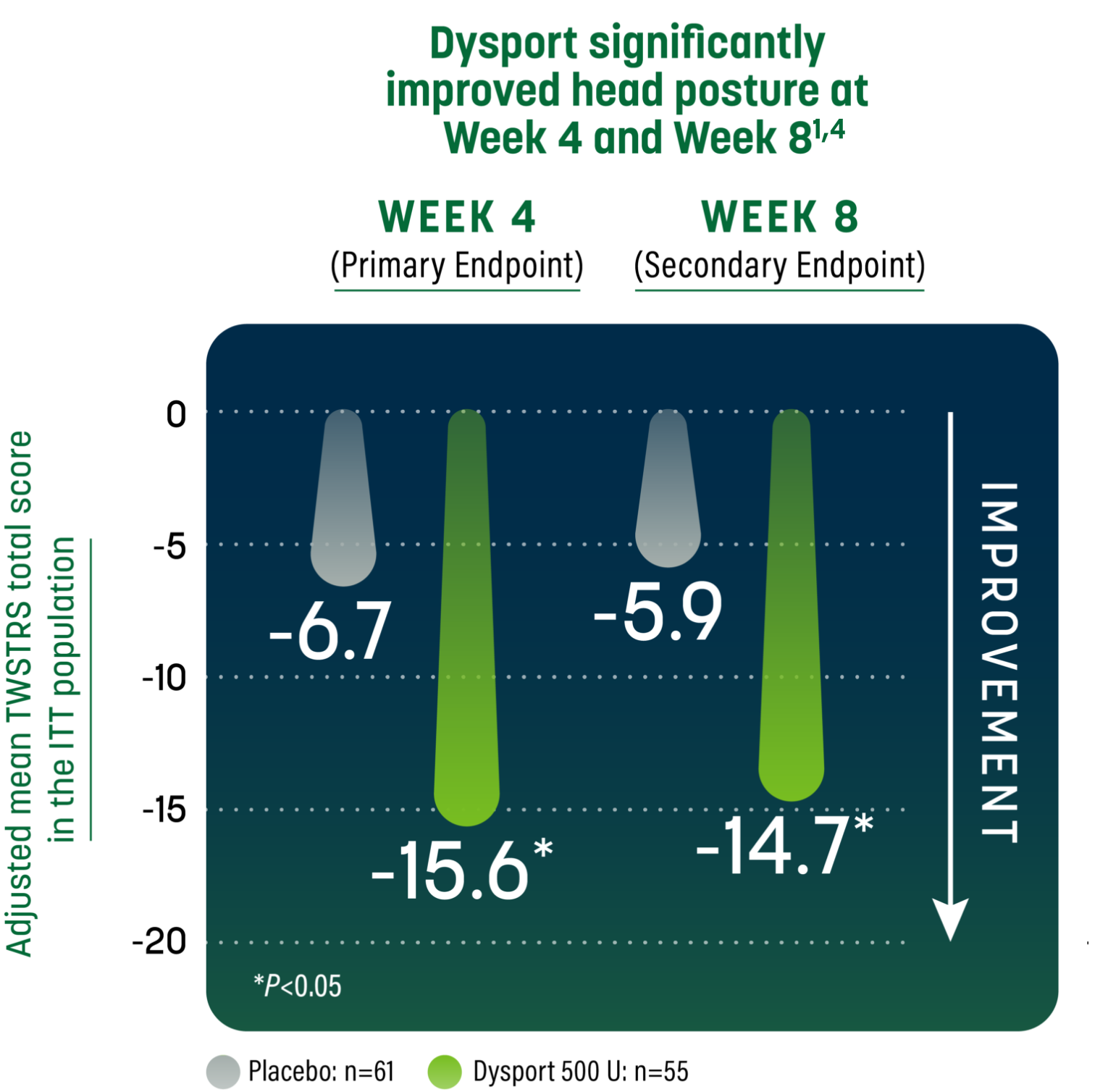
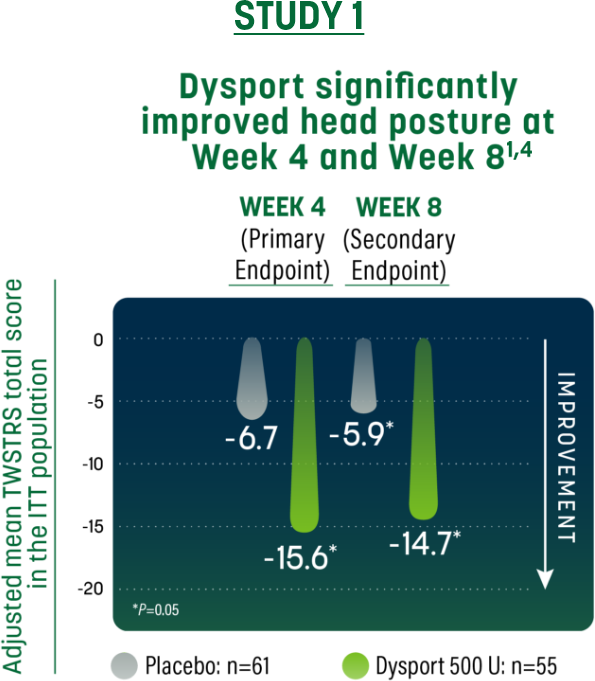
- The primary assessment of efficacy was based on the total TWSTRS change from baseline at Week 41
- Total score at baseline (mean [SD]): placebo, 45.8 (8.9); Dysport 500 Units, 43.8 (8.0)1
STUDY 2
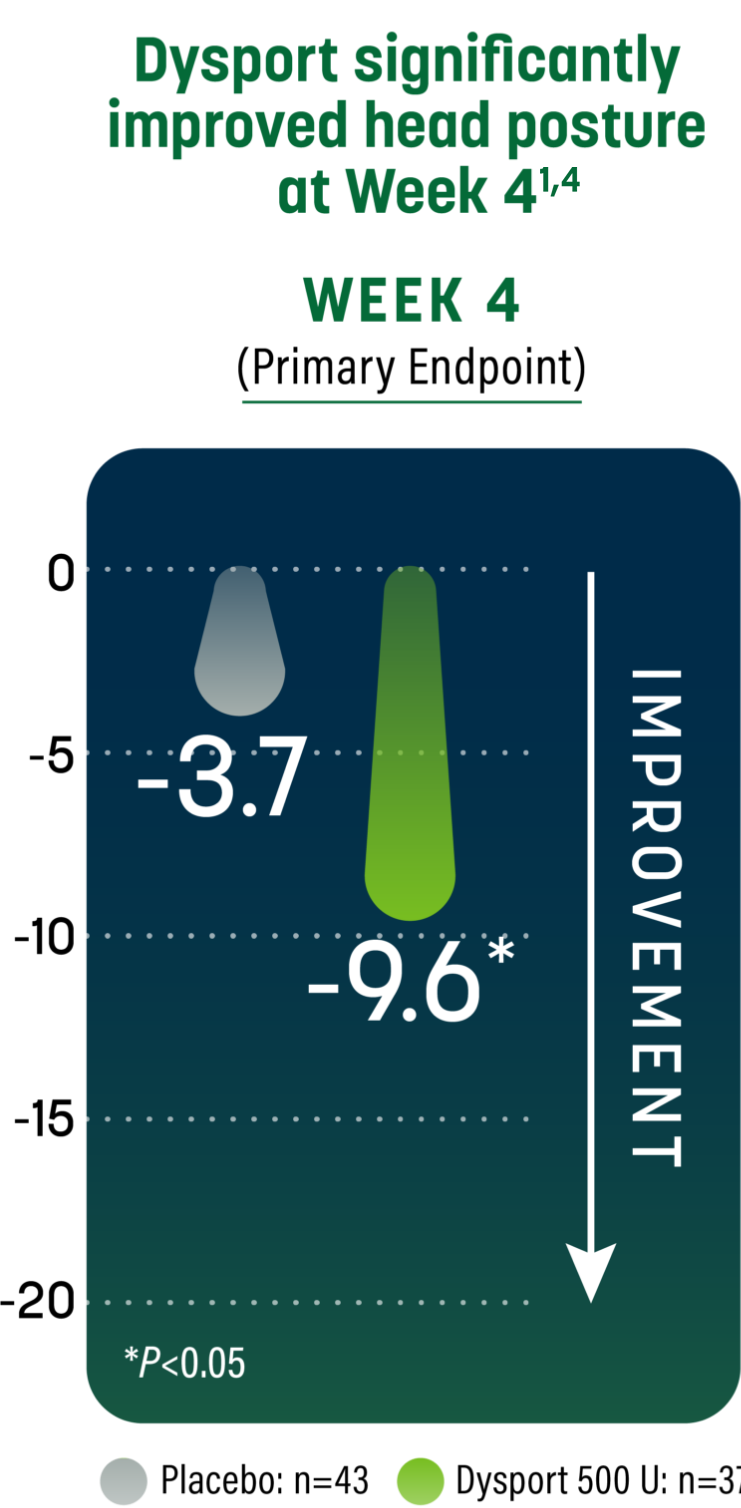
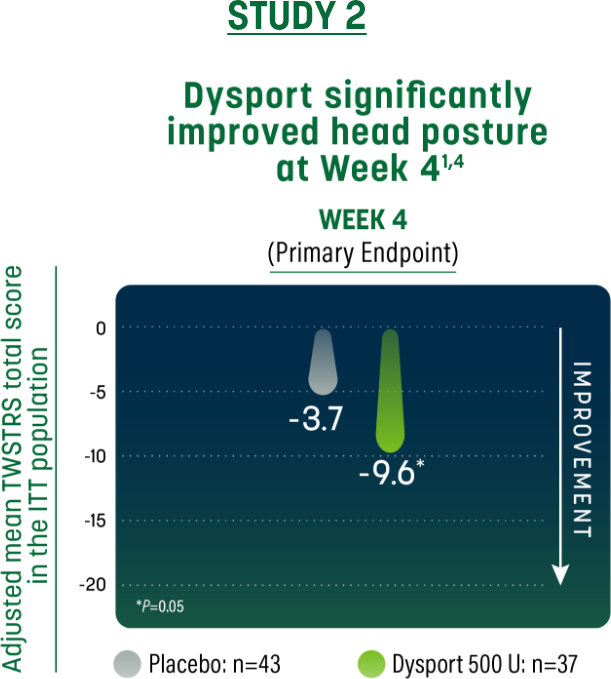
- The primary assessment of efficacy was based on the total TWSTRS change from baseline at Week 4
- Total score at baseline (mean [SD]): placebo, 46.2 (9.4); Dysport 500 Units, 45.1 (8.7)1
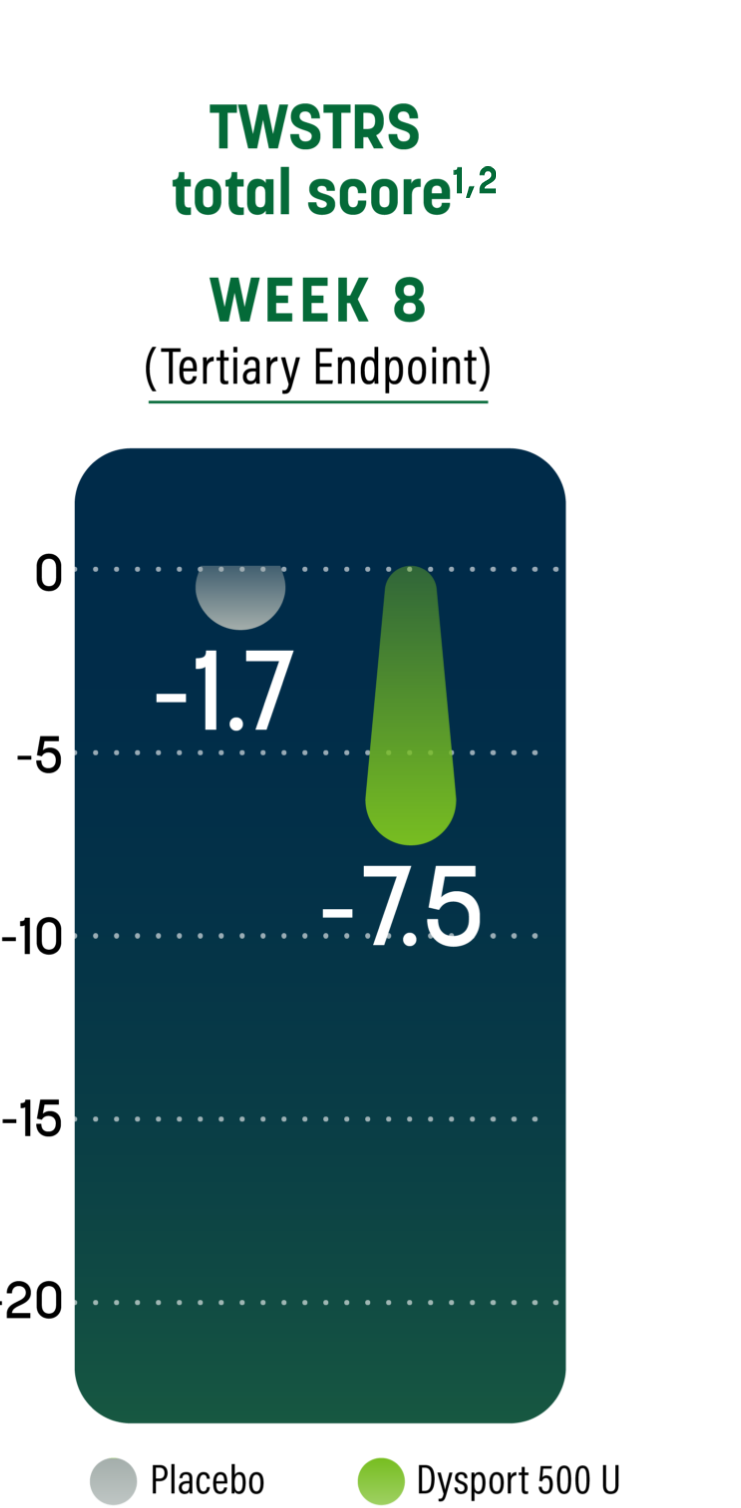
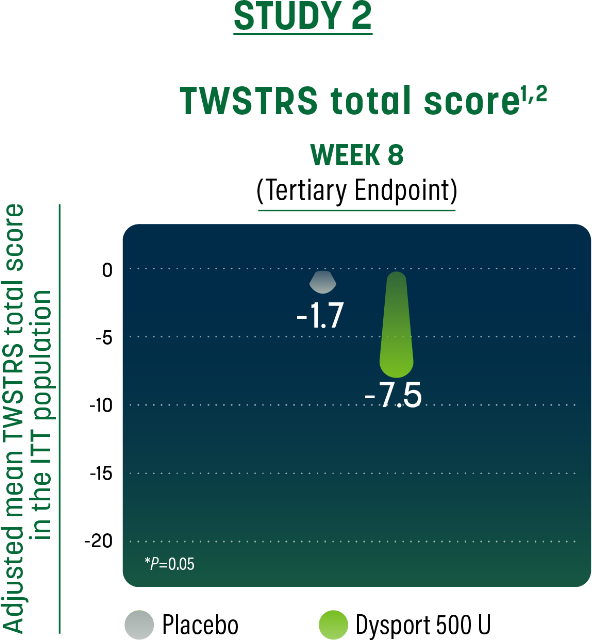
Study Limitations: Week 8 results may represent chance findings, as multiplicity adjustments were not applied; therefore, the results should be interpreted cautiously.
- Change in TWSTRS total score at Week 81,2
Study participants included both toxin-naive† and toxin non-naive patients.2,4

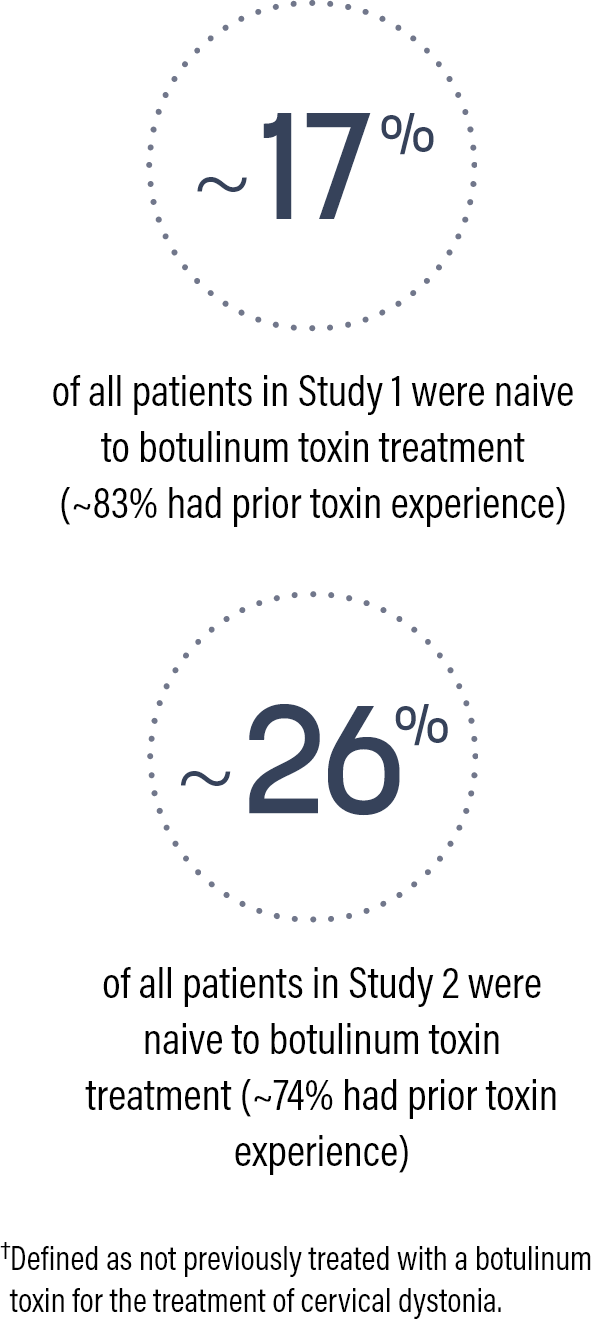
Visual Analogue Scale (VAS) at Week 4 and Week 8
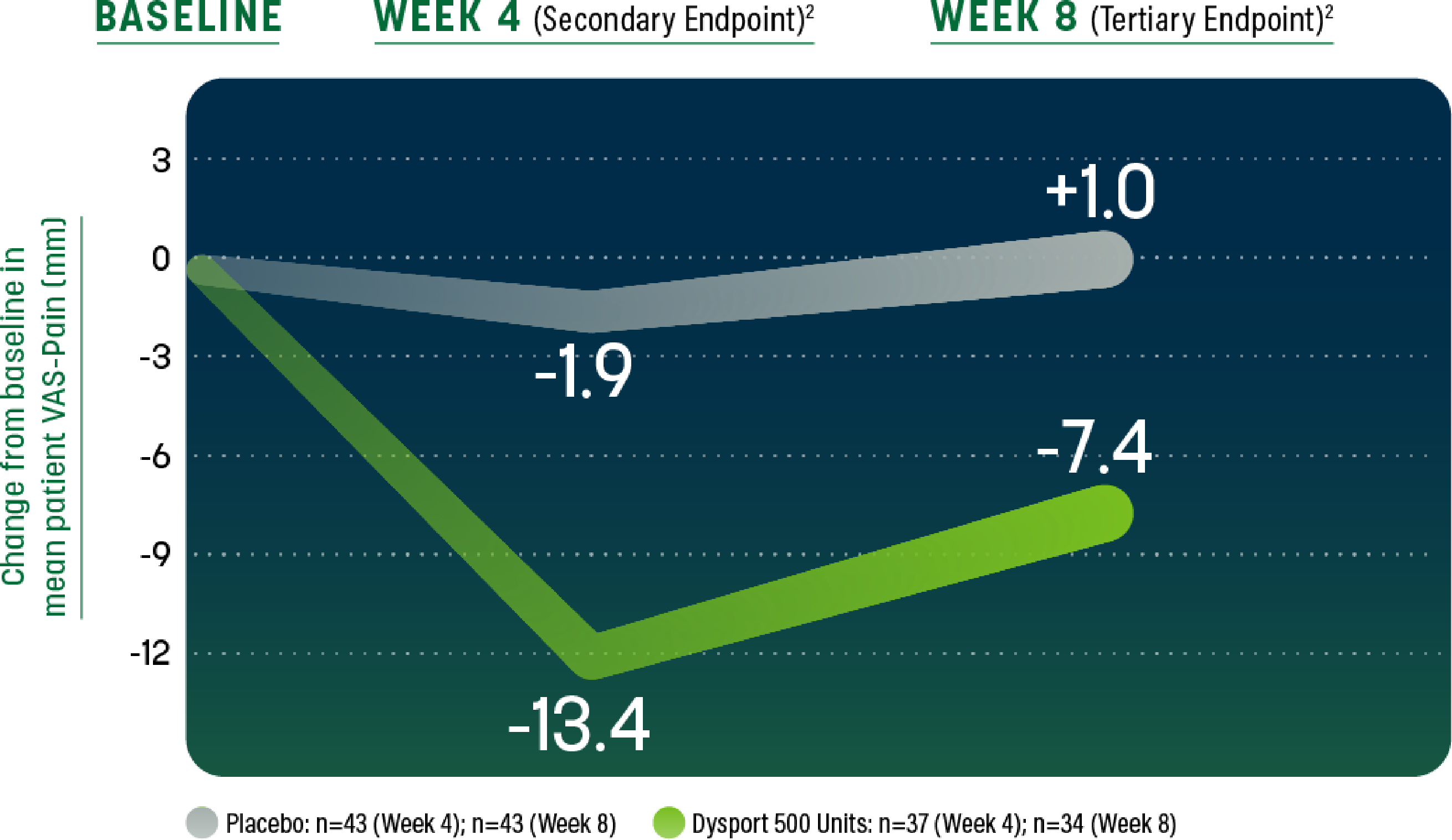
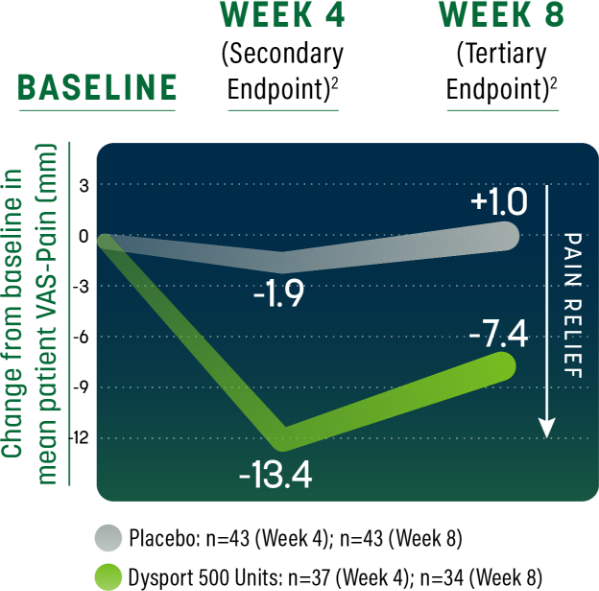
Study limitations: Data may represent chance findings, as multiplicity adjustments were not applied; therefore, the results should be interpreted cautiously.
- Baseline VAS score (patient self-rated) was 48.6 in the Dysport group and 52.9 in the placebo group2
- Evaluated on a 100-point VAS pain scale (0 mm [no symptoms] to 100 mm [worst possible symptoms]) following treatment.2
Sustained relief beyond the minimum time to re-treatment
For most patients with CD, Dysport lasted beyond the minimum re-treatment time of 12 weeks.1
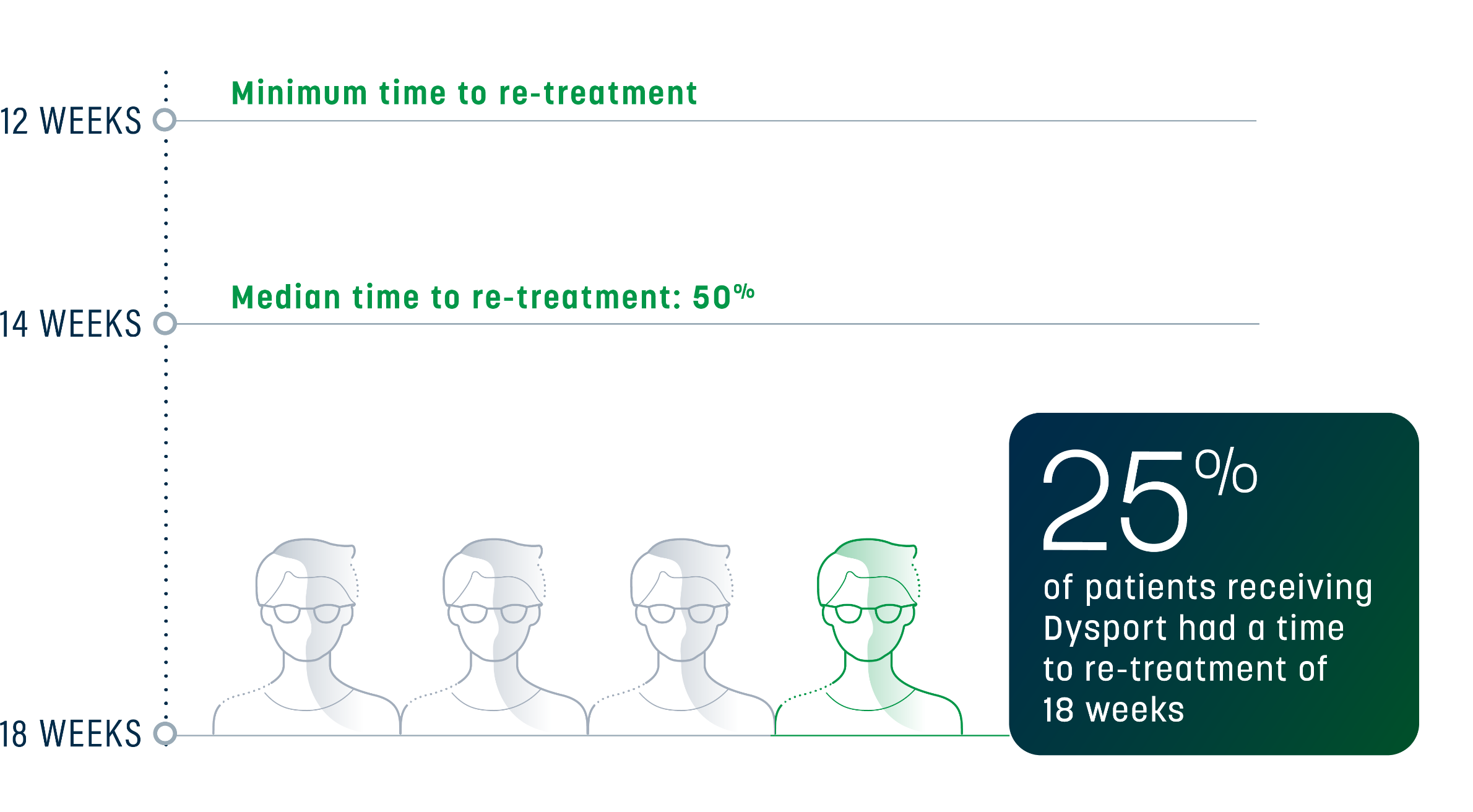
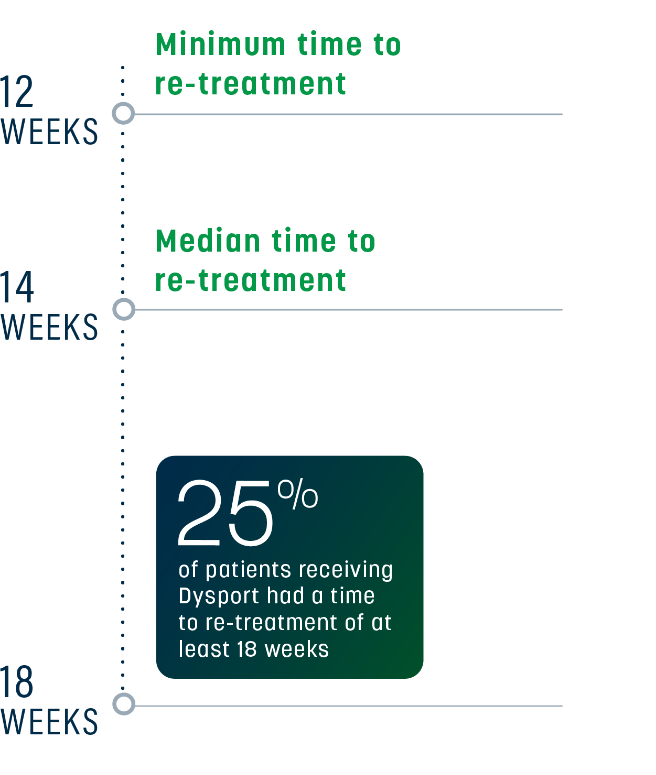
Re-treatment was determined by clinical need after a minimum of 12 weeks. The median time to re-treatment was 14 weeks and 18 weeks for the 75th percentile.
In the pivotal trials for Adult CD, re-treatment was determined by clinical need after a minimum of 12 weeks, as determined by change in TWSTRS total score returning to within 10% of baseline or investigator’s discretion.2
Repeat Dysport re-treatment should be administered no sooner than 12 weeks after the previous injection.
Learn more about Dysport for cervical dystonia
INDICATIONS
DYSPORT (abobotulinumtoxinA) for injection is indicated for the treatment of:
- spasticity in patients 2 years of age and older
- cervical dystonia in adults
Please see full Prescribing Information, including BOXED WARNING.
IMPORTANT SAFETY INFORMATION
Warning: Distant Spread of Toxin Effect
Postmarketing reports indicate that the effects of DYSPORT and all botulinum toxin products may spread from the area of injection to produce symptoms consistent with botulinum toxin effects. These may include asthenia, generalized muscle weakness, diplopia, blurred vision, ptosis, dysphagia, dysphonia, dysarthria, urinary incontinence and breathing difficulties. These symptoms have been reported hours to weeks after injection. Swallowing and breathing difficulties can be life threatening and there have been reports of death. The risk of symptoms is probably greatest in children treated for spasticity but symptoms can also occur in adults treated for spasticity and other conditions, particularly in those patients who have underlying conditions that would predispose them to these symptoms. In unapproved uses and in approved indications, cases of spread of effect have been reported at doses comparable to or lower than the maximum recommended total dose.
Contraindications
DYSPORT is contraindicated in patients with known hypersensitivity to any botulinum toxin products, cow’s milk protein, or to any of the components in the formulation, or infection at the proposed injection site(s). Serious hypersensitivity reactions including anaphylaxis, serum sickness, urticaria, soft tissue edema, and dyspnea have been reported. If such a serious reaction occurs, discontinue DYSPORT and institute appropriate medical therapy immediately.
Warnings and Precautions
Lack of Interchangeability Between Botulinum Toxin Products
The potency Units of DYSPORT are specific to the preparation and assay method utilized. They are not interchangeable with other preparations of botulinum toxin products and, therefore, units of biological activity of DYSPORT cannot be compared to or converted into units of any other botulinum toxin products assessed with any other specific assay method.
Dysphagia and Breathing Difficulties
Treatment with DYSPORT and other botulinum toxin products can result in swallowing or breathing difficulties. Patients with pre-existing swallowing or breathing difficulties may be more susceptible to these complications. In most cases, this is a consequence of weakening of muscles in the area of injection that are involved in breathing or swallowing. When distant effects occur, additional respiratory muscles may be involved. Deaths as a complication of severe dysphagia have been reported after treatment with botulinum toxin. Dysphagia may persist for several weeks and require use of a feeding tube to maintain adequate nutrition and hydration. Aspiration may result from severe dysphagia and is a particular risk when treating patients in whom swallowing or respiratory function is already compromised. Treatment of cervical dystonia with botulinum toxins may weaken accessory muscles of ventilation, which may result in a critical loss of breathing capacity in patients with respiratory disorders who may have become dependent upon these muscles. Patients treated with botulinum toxin may require immediate medical attention should they develop problems with swallowing, speech, or respiratory disorders. These reactions can occur within hours to weeks after injection with botulinum toxin.
Pre-existing Neuromuscular Disorders
Individuals with peripheral motor neuropathic diseases, amyotrophic lateral sclerosis, or neuromuscular junction disorders (e.g., myasthenia gravis or Lambert-Eaton syndrome) should be monitored particularly closely when given botulinum toxin. Patients with neuromuscular disorders may be at increased risk of clinically significant effects including severe dysphagia and respiratory compromise from typical doses of DYSPORT.
Human Albumin and Transmission of Viral Diseases
This product contains albumin, a derivative of human blood. Based on effective donor screening and product manufacturing processes, it carries an extremely remote risk for transmission of viral diseases and variant Creutzfeldt-Jakob disease (vCJD). There is a theoretical risk for transmission of Creutzfeldt-Jakob disease (CJD), but if that risk actually exists, the risk of transmission would also be considered extremely remote. No cases of transmission of viral diseases, vCJD, or CJD have ever been identified for licensed albumin or albumin contained in other licensed products.
Intradermal Immune Reaction
The possibility of an immune reaction when injected intradermally is unknown. The safety of DYSPORT for the treatment of hyperhidrosis has not been established. DYSPORT is approved only for intramuscular injection.
Pre-existing Conditions at the Injection Site
Caution should be exercised when DYSPORT is used where the targeted muscle shows excessive weakness or atrophy.
Adverse Reactions
- The most common adverse reactions (≥4%) in adults with upper limb spasticity include muscular weakness; in adults with lower limb spasticity (≥5%) include falls, muscular weakness, and pain in extremity
- The most common adverse reactions (≥10%) in pediatric patients with upper limb spasticity include upper respiratory tract infection and pharyngitis; in pediatric patients with lower limb spasticity include nasopharyngitis, cough, and pyrexia
- The most common adverse reactions (≥5%) in adults with cervical dystonia include muscular weakness, dysphagia, dry mouth, injection site discomfort, fatigue, headache, musculoskeletal pain, dysphonia, injection site pain, and eye disorders
Drug Interactions
Co-administration of DYSPORT and aminoglycosides or other agents interfering with neuromuscular transmission (e.g., curare-like agents) should only be performed with caution because the effect of the botulinum toxin may be potentiated. Use of anticholinergic drugs after administration of DYSPORT may potentiate systemic anticholinergic effects such as blurred vision. The effect of administering different botulinum neurotoxins at the same time or within several months of each other is unknown. Excessive weakness may be exacerbated by another administration of botulinum toxin prior to the resolution of the effects of a previously administered botulinum toxin. Excessive weakness may also be exaggerated by administration of a muscle relaxant before and after administration of DYSPORT.
Please see full Prescribing Information, including BOXED WARNING.
References:
- Dysport® (abobotulinumtoxinA) [Prescribing Information]. Cambridge, MA: Ipsen Biopharmaceuticals, Inc; September 2023.
- Data on file. Cambridge, MA. Ipsen Biopharmaceuticals, Inc.
- Truong D, Duane DD, Jankovic J, et al. Efficacy and safety of botulinum type A toxin (Dysport) in cervical dystonia: results of the first US randomized, double-blind, placebo-controlled study. Mov Disord. 20(7):783-791.
- Truong D, Brodsky M, Lew M, et al. Long-term efficacy and safety of botulinum toxin type A (Dysport) in cervical dystonia. Parkinsonism Relat Disord. 16(5):316-323.








